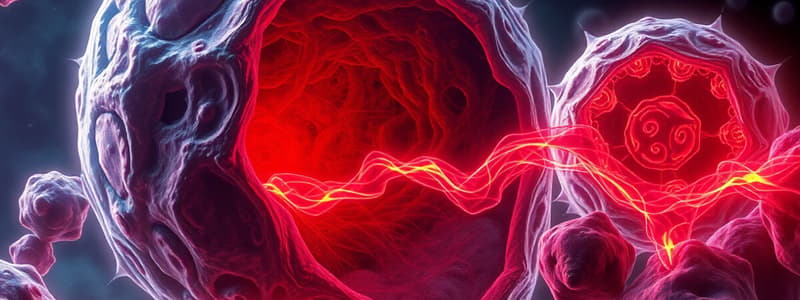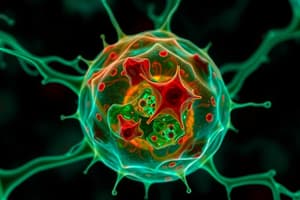Podcast
Questions and Answers
What is one possible outcome of immune aggression in the context of disease?
What is one possible outcome of immune aggression in the context of disease?
- Release of growth factors
- Enhanced cellular repair
- Cell starvation (correct)
- Increased bacterial growth
Which of the following illustrates a way that homeostasis disruption can affect cells?
Which of the following illustrates a way that homeostasis disruption can affect cells?
- Enhancing cell communication
- Causing irreparable damage (correct)
- Increasing energy production
- Promoting uniform cell structure
What is a common characteristic of rapidly dividing cancer cells?
What is a common characteristic of rapidly dividing cancer cells?
- High demand for nutrients (correct)
- Increased susceptibility to disease
- Ability to repair damage effectively
- Difficulty in maintaining size
What happens to cells undergoing atrophy?
What happens to cells undergoing atrophy?
What is a potential indicator of aging at the cellular level?
What is a potential indicator of aging at the cellular level?
Flashcards
Disease
Disease
A condition characterized by a disruption of normal function or structure in a body.
Aging
Aging
The natural process of growing older, often accompanied by changes in structure and function.
Cancer
Cancer
A disease characterized by uncontrolled growth of cells.
Cell Death
Cell Death
Signup and view all the flashcards
Homeostasis Disruption
Homeostasis Disruption
Signup and view all the flashcards
Study Notes
Necrosis vs. Apoptosis
- Necrosis is cell injury, while apoptosis is programmed cell death
- Cells with necrosis swell and die externally, while apoptosis cells shrink externally and are cleaned up by phagocytosis
- You need to be able to discuss cell death, mechanisms for injury, and cellular responses to stress and injury
Overview of Cellular Response to Stress and Injury
- Cells are constantly adapting to extracellular stresses
- Cells actively maintain homeostasis
- Cells encounter physiologic or pathologic stimuli.
- Adaptation preserves cell viability and function
- If the adaptive ability is exceeded, or an external stress is harmful, it causes cell injury
- Cell injury can be reversed within limits.
- Severe or persistent stress leads to irreversible injury and cell death.
- Cell death is critical in normal cells and for disease development.
Causes of Stress and Injury
- Causes are grouped into categories
- Oxygen deprivation (hypoxia)
- Chemical agents
- Infectious agents (bacteria, fungi, viruses, etc.)
- Immunological reactions (autoimmune responses)
- Genetic defects (protein deficiencies, damaged DNA)
- Nutritional imbalances (starvation)
- Physical agents (trauma, changes in temperature, pH)
- Aging
Cellular Adaptations to Stress
- Adaptations are reversible changes in response to environmental changes
- Physiological Adaptations
- Response to normal stimulation (hormones and chemical mediators)
- Pathological Adaptations
- Response to stress, which modulates structure and function to prevent injury
- Hypertrophy (increase in cell size)
- Hyperplasia (increase in cell number)
- Atrophy (decrease in cell size)
- Metaplasia (change in cell type)
- Response to stress, which modulates structure and function to prevent injury
- Physiological Adaptations
Cellular Adaptations to Stress: Hypertrophy
- Cellular size increases, as does the size of the organ containing those cells
- No new cells, but cells become bigger
- Due to increased amounts of structural proteins and organelles
- Happens when non-dividing cells are exposed to stress
- Examples include myocardium and skeletal muscle cells. Increase in workload or hormonal stimulation can cause this.
Cellular Adaptations to Stress: Hyperplasia
- Increase in number of cells; increases organ size
- Only occurs in cells that can replicate (mitosis)
- Can occur with hypertrophy in response to similar stimuli (physiologic or pathologic)
- Physiological hyperplasia:
- Hormonal (e.g., breast development during puberty and pregnancy)
- Compensatory (e.g., liver regeneration after resection)
- Pathologic hyperplasia:
- Excessive hormone or growth factor stimulation (e.g., HPV and warts)
- Irreversible hyperplasia can lead to dysplasia and cancer
Cellular Adaptations to Stress: Atrophy
- Decrease in cell/organ size by loss of cell substance
- Reduced protein synthesis and increased degradation
- Cells lose function but aren’t dead
- Often accompanied by autophagy ("self-eating")
- Physiologic atrophy: decreased workload, reduced blood supply
- Pathologic atrophy: prolonged decreased workload or diminished blood supply
Cellular Adaptations to Stress: Metaplasia
- Reversible change where one cell type is replaced by another
- Cells resistant to certain stressors replace other, more sensitive cells
- Likely a result of "genetic reprogramming" of stem cells
- Most common in short-lived, rapidly replaced epithelial cells (e.g., respiratory epithelium in cigarette smokers)
- May result in reduced function or an increased chance of malignant transformation
Overview of Cell Injury and Cell Death
- Cell injury occurs when cells are severely stressed or exposed to damaging agents
- Cells attempt to adapt, otherwise injury occurs
- Injury may be reversible or irreversible
- Pathways of cell death:
- Necrosis
- Apoptosis
Overview of Cell Injury: Reversible Cell Injury
- Early or mild forms of injury
- Functional and morphological changes are reversible if the stimulus is removed; Examples include swelling of the ER and mitochondria.
Overview of Cell Injury: Reversible Cell Injury - Morphological Changes
- Specific examples include swelling of cells and the formation of surface blebs, such as in the kidney tubules
Overview of Cell Injury: Reversible Cell Injury - Changes in Cell Replication
- DNA damage often leads to cell cycle arrest in the G1 phase
Overview of Cell Injury and Cell Death: Cell Death
- If the injury is sustained, injury becomes irreversible.
Overview of Cell Injury and Cell Death: Cell Death - Necrosis
- Major cell death pathway in many commonly encountered injuries
- Always a pathological process
- Cellular contents leak and cause inflammation
- Includes:
- Degradative actions of enzymes
- Morphological alterations (nuclear shrinkage, fragmentation)
- Breakdown of plasma and organelle membranes
- Leakage and enzymatic digestion of cellular contents
- Occurs in collections of cells in tissues or organs
Overview of Cell Injury and Cell Death: Cell Death - Apoptosis
- Activated by a tightly controlled suicide program; involves cell's own enzymes degrading itself
- Plasma membrane intact
- No cellular contents leak out
- No inflammatory response; cells recognized and removed by phagocytes
- Involved in normal physiological processes and pathological situations
- Cellular changes (cell shrinkage, chromatin condensation, membrane blebbing, nuclear fragmentation, formation of apoptotic bodies, phagocytosis)
Cell Death: Apoptosis - Physiological Induction
- Apoptosis is induced by both physiological and pathological conditions
- Physiological
- Cells are eliminated when no longer needed or when cell populations in the tissue must be maintained
- Pathological
- Elimination of cells genetically altered or injured beyond repair
- Physiological
Cell Death: Apoptosis - Mechanisms
- Apoptosis follows a tightly regulated pathway, either intrinsic (mitochondrial) or extrinsic (receptor-ligand)
Cell Death: Summary
- Cell death proceeds via apoptosis or necrosis based on stimuli. Both processes are tightly regulated at a molecular level via different pathways to maintain homeostasis. Apoptosis removes damaged cells while necrosis can lead to inflammation and further damage to surrounding tissues.
Studying That Suits You
Use AI to generate personalized quizzes and flashcards to suit your learning preferences.
Related Documents
Description
This quiz explores the differences between necrosis and apoptosis, highlighting their roles in cellular injury and death. You'll learn about the mechanisms behind cell responses to stress and injury, as well as how they adapt or fail under various conditions. Understanding these processes is crucial for grasping the implications in normal physiology and disease development.




